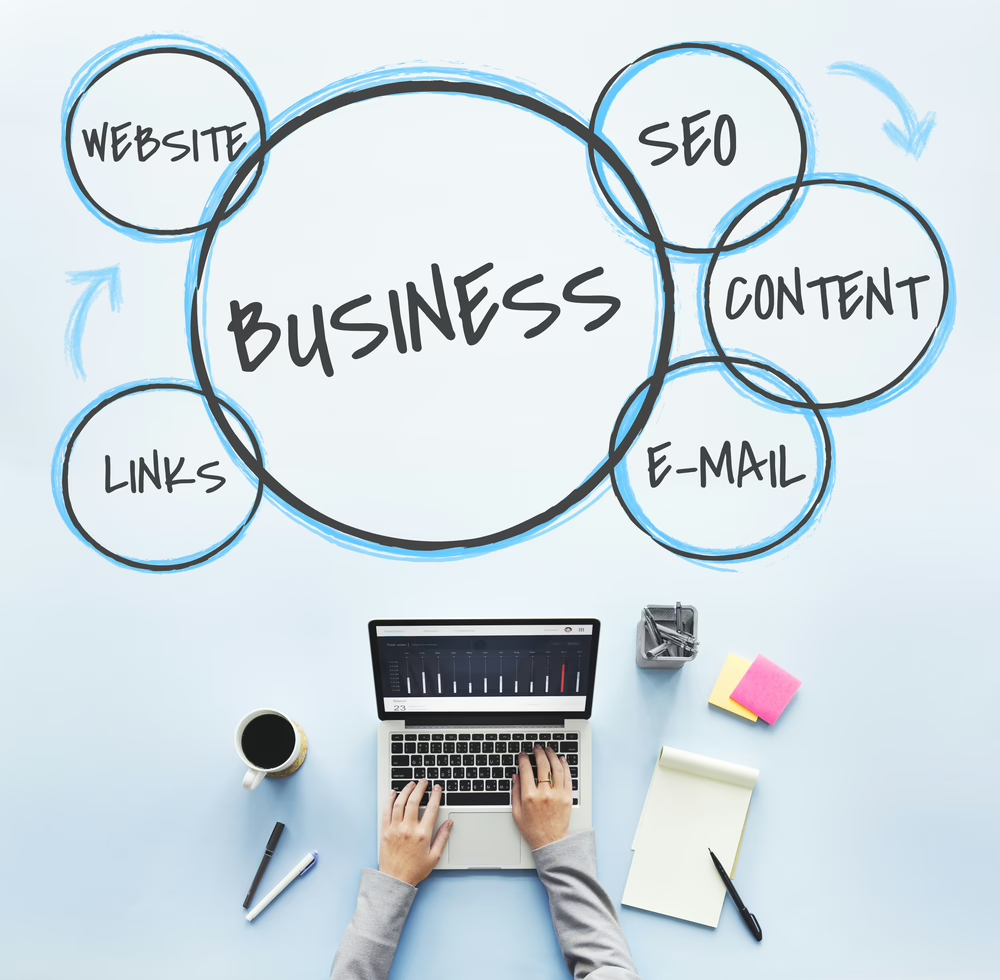
11 Tips and Tricks for the Best Possible UX Design
Your website’s user experience (UX) can make or break a sale. To attract and keep customers, you want great UX.
Here are eleven top Las Vegas UX design tips and tricks to help you improve website usability:
 A website with good UX flows smoothly from one point to another. The same is true for every page, too. For example, an effective and UX-optimized homepage contains content that is relevant to what users want. Stuffing it with too much information is not good.
Keep your pages simple and clean by using call to action (CTA) buttons to direct users to other pages. They also help you avoid overwhelming users with excessive amounts of information. CTA buttons that say “read more” or “learn more” are good segues to landing pages with full information.
A website with good UX flows smoothly from one point to another. The same is true for every page, too. For example, an effective and UX-optimized homepage contains content that is relevant to what users want. Stuffing it with too much information is not good.
Keep your pages simple and clean by using call to action (CTA) buttons to direct users to other pages. They also help you avoid overwhelming users with excessive amounts of information. CTA buttons that say “read more” or “learn more” are good segues to landing pages with full information.
 How you organize your website has a major effect on its usability and the quality of the UX that it offers. Not all of your content has to be immediately visible on a page. Menus help organize content into relevant categories so that users only see major content.
One way to address inefficiencies in site structure is by hiring a Las Vegas UX design agency to apply information architecture (IA) to your website. IA is one of the essential skills of a good UX designer that helps you get the most out of your business’s website.
How you organize your website has a major effect on its usability and the quality of the UX that it offers. Not all of your content has to be immediately visible on a page. Menus help organize content into relevant categories so that users only see major content.
One way to address inefficiencies in site structure is by hiring a Las Vegas UX design agency to apply information architecture (IA) to your website. IA is one of the essential skills of a good UX designer that helps you get the most out of your business’s website.
 Usability features are not all complicated graphics or technical elements. They are as simple as the color and typography that you apply to your brand and website. For instance, using too many colors can overwhelm users, making focusing difficult.
This also goes against compliance with the Americans with Disabilities Act (ADA) because it affects the UX for people with colorblindness or vision disabilities. Treat fonts in the same manner. Simple sans-serif fonts are often the safest choice.
Usability features are not all complicated graphics or technical elements. They are as simple as the color and typography that you apply to your brand and website. For instance, using too many colors can overwhelm users, making focusing difficult.
This also goes against compliance with the Americans with Disabilities Act (ADA) because it affects the UX for people with colorblindness or vision disabilities. Treat fonts in the same manner. Simple sans-serif fonts are often the safest choice.
- Keep pages simple and concise.
- Manage how content flows.
- Optimize pages to boost speed.
- Choose a responsive site design.
- Organize the website’s structure.
- Use CTAs to direct user actions.
- Add survey and feedback forms.
- Implement features users need.
- Be careful with colors and fonts.
- Remove unnecessary elements.
- Do annual technical SEO audits.
To learn how Digital Authority Partners can create a standout website for you, watch this video!
1. Keep Pages Simple and Concise
Good UX involves giving users what they want and directly delivering it, all without unnecessary delays. In other words, to have good UX, keep your pages simple and concise. If it has no value for users, it probably has no place on your website. For instance, if you publish a recipe, users do not need to know the origin story of the recipe. Any reliable Las Vegas UX design agency can advise that it goes against UX to bury valuable content. Give users what they want.2. Manage How Your Content Flows
 A website with good UX flows smoothly from one point to another. The same is true for every page, too. For example, an effective and UX-optimized homepage contains content that is relevant to what users want. Stuffing it with too much information is not good.
Keep your pages simple and clean by using call to action (CTA) buttons to direct users to other pages. They also help you avoid overwhelming users with excessive amounts of information. CTA buttons that say “read more” or “learn more” are good segues to landing pages with full information.
A website with good UX flows smoothly from one point to another. The same is true for every page, too. For example, an effective and UX-optimized homepage contains content that is relevant to what users want. Stuffing it with too much information is not good.
Keep your pages simple and clean by using call to action (CTA) buttons to direct users to other pages. They also help you avoid overwhelming users with excessive amounts of information. CTA buttons that say “read more” or “learn more” are good segues to landing pages with full information.
3. Optimize Pages To Boost Speed
Another key UX feature that users love is fast loading speeds. Most people are busy with tasks to do and places to be, so they have little time. Waiting for a website to load is an inefficiency for which users have no patience, as they can find similarly valuable content elsewhere. When you fail to optimize on-page elements, they start to weigh down the page’s load speed. Large images and full videos slow down the page, which causes users to leave and find a different website. Instead, scale down images, upload videos to YouTube, and embed them.4. Choose a Responsive Site Design
People access your website from different devices (smartphones, tablets, and PCs), which means it displays on various screen sizes. Using responsive design is one way to enhance UX because it enables users to open your website wherever and whenever they want. When you apply responsive (or mobile-friendly) design, your page and its contents automatically adapt to the device’s screen. Font size, image size, and the placement of certain user interface (UI) elements immediately shift and change to fit the display. You have the ability to influence these elements.5. Organize the Website’s Structure
 How you organize your website has a major effect on its usability and the quality of the UX that it offers. Not all of your content has to be immediately visible on a page. Menus help organize content into relevant categories so that users only see major content.
One way to address inefficiencies in site structure is by hiring a Las Vegas UX design agency to apply information architecture (IA) to your website. IA is one of the essential skills of a good UX designer that helps you get the most out of your business’s website.
How you organize your website has a major effect on its usability and the quality of the UX that it offers. Not all of your content has to be immediately visible on a page. Menus help organize content into relevant categories so that users only see major content.
One way to address inefficiencies in site structure is by hiring a Las Vegas UX design agency to apply information architecture (IA) to your website. IA is one of the essential skills of a good UX designer that helps you get the most out of your business’s website.
6. Use CTAs To Direct User Actions
CTA buttons are excellent for managing the flow of content on your pages and throughout the website. They also help direct users to where they should go to find information relevant to their search or to perform conversion actions such as purchasing. This is good for UX because it makes your website more intuitive and usable. It addresses basic navigation issues with a simple interactive solution. Space them out and use them sparingly. Otherwise, you will inadvertently create another UX problem.7. Add Survey and Feedback Forms
Customers have opinions, and they need an appropriate outlet to express them. Presenting users with surveys and customer service forms allows you to address this problem while also benefiting everyone involved. Not all feedback is negative. Positive ones point out what your business and website do right for customers. Surveys and feedback forms are, in many ways, essential for a solid UX strategy because they make identifying areas for improvement effortless on your part.8. Implement Features Users Need
Every user has unique needs, but when you group users according to demographic features, you pinpoint broad needs among your target market. For example, a defining characteristic of Millennial and Gen Z customers is their focus on convenience as a good service feature. Having grown up with technology, these users are well acquainted with the speed and ease that it brings. They also expect businesses to adapt to rapid technological advancements in order to maintain value and appeal to younger audiences.9. Be Careful With Colors and Fonts
 Usability features are not all complicated graphics or technical elements. They are as simple as the color and typography that you apply to your brand and website. For instance, using too many colors can overwhelm users, making focusing difficult.
This also goes against compliance with the Americans with Disabilities Act (ADA) because it affects the UX for people with colorblindness or vision disabilities. Treat fonts in the same manner. Simple sans-serif fonts are often the safest choice.
Usability features are not all complicated graphics or technical elements. They are as simple as the color and typography that you apply to your brand and website. For instance, using too many colors can overwhelm users, making focusing difficult.
This also goes against compliance with the Americans with Disabilities Act (ADA) because it affects the UX for people with colorblindness or vision disabilities. Treat fonts in the same manner. Simple sans-serif fonts are often the safest choice.
10. Remove Unnecessary Elements
Simplicity and minimalism are two emerging UX trends, with the emphasis being on usability. Flashy features are nice, but users become frustrated and disappointed if they have no substance. The top priority for good Las Vegas UX design is refining your website’s or app’s usability before upgrading user interface (UI) elements. When you work on UI before UX, you unintentionally hurt the latter because your product’s usability loses value for your users.11. Do Annual Technical SEO Audits
Although many UX elements, such as responsive design and site structure, require rigorous optimization testing, others, such as links and CTAs, depend on technical SEO audits to be corrected. That does not mean one is more important than the other, as you need both. According to Las Vegas UX design experts, you should perform a technical SEO audit at least once a year to ensure that everything on your website works properly. Errors significantly lower UX, and many go unchecked without a comprehensive site audit.Summing Up
Achieving top-notch UX design is only possible when you learn how to optimize its different aspects, such as color and font, which can sometimes reduce visibility and usability. Website loading speed and intuitive navigation are other critical elements that require your attention. Overall, improving UX and usability requires expert knowledge to be properly addressed. Need help getting the best UX design for your business? Contact Digital Authority Partners (DAP) to learn how we can help.Want To Meet Our Expert Team?
Book a meeting directly here



